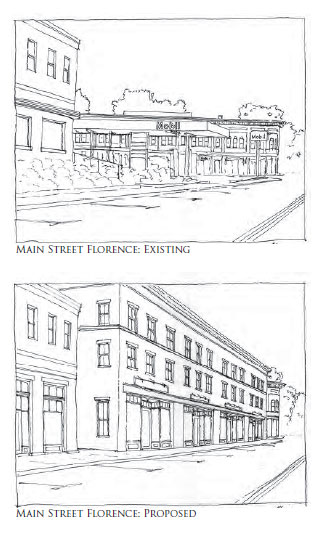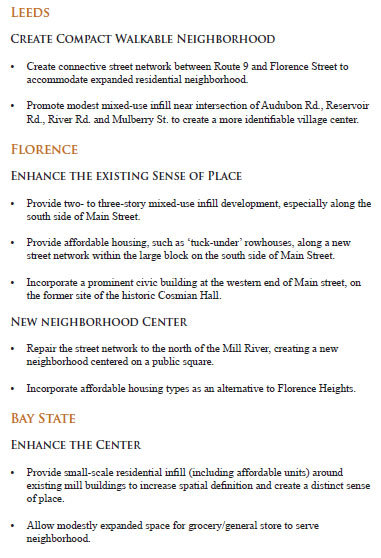Here is a complete blip.tv video of the general session of Northampton Design Forum‘s public forum at the Florence Civic Center on 7/27/09. As publicized in NDF’s flyer, “The purpose of the forum is to facilitate public dialogue about the principles of sustainability and neighborhood design, including the concepts presented by the Notre Dame Urban Design Studio for two areas of Florence, as well as for Baystate center and Leeds.” This video was recorded by Adam Cohen and is 1 hour and 24 minutes long.
Video highlight (1:06:02-1:07:48)
Deb Jacobs, Chair of the Northampton Tree Committee: “…One of the things that I think is a challenge and is difficult is the fact that [in] a lot of Leeds and a lot of different areas of the city, there are rivers and wetlands. Just because you’ve got an open space, you can’t just plunk houses and businesses in, because there are brooks and streams. It’s expensive. I think that it’s really important to look at what’s actually there before you make proposals. Because I think that one of the reasons why neighborhoods get up in arms sometimes – I know mine did – was because of wetlands. I think that you guys need to set the tone… You need to make that an important part… It’s not that you can’t build near them but…it’s really important to preserve them. I guess the big example is the hurricane down in New Orleans where the wetlands had been so encroached… The bikepath behind my house – they’re spending most of their time with drainage because it’s so wet… I really think that design people have to put wetlands back into their thoughts.”
Here are selections from pages 61-62 of Envisioning Sustainable Northampton, produced by the Notre Dame School of Architecture: 



See also:
Video: Public Forum on Planning and Sustainability, 3/11/09
Download Envisioning Sustainable Northampton – Final Notre Dame Studio Presentation Book
Envisioning Sustainable Northampton: Notre Dame Urban Design Presentation – Video and Handout
Envisioning Sustainable Northampton: Notre Dame Urban Design Presentation – Slides
Video and Slides: Final Presentation of Design Northampton Week
Video: First public “in-process” presentation and feedback session for Design Northampton Week
Fran Volkmann, Vice Chair, Community Preservation Committee
1:09:26-1:10:57
We would like to concentrate development closer in, we like the idea of walkability, bikeability, neighborhood center… The thing that happens to us, however, is that we buy that and then somebody builds some horrible thing…and then they say to you, “This is infill, you know. It’s good, it’s infill.” …You know if you walk in European cities, you very often find little tiny pocket parks, and little bits of green spaces, mixed in with beautiful buildings… How do we…learn to…value…respect for people at the same time that we try to fill in our park spaces?
Photo Essay: Nature Summers at Millyard Brook
The woods and wetlands around Millyard Brook and Woodmont Road may not be pristine habitats, but they are an oasis for animals in downtown Northampton, and beloved by the people who live there. Will these sights be infilled away?
Latest Kohl Condo Proposal for North Street: 20 Units as Duplexes
While the new condo proposal is a move in the right direction, many important issues remain:
- Units 5-12 would be in an area that Conservation Commissioner Paul Wetzel objects to building on because the ground is so wet (March 12 hearing)
- Wetzel also expressed concerns about how the underground stormwater detention system by Unit 10 would interact with groundwater in and around the wetland
- Unit 18 appears to be slated for the same place as a unit that Conservation Commissioner Downey Meyer objected to previously as too close to the wetland
- The total amount of disturbance inside the 100-foot wetlands buffer zone would remain high; Meyer objected to this on the version of the proposal reviewed on March 12
3:38:39… Meyer: “But at the same time, this is the wetland that the people living in this part of the city have. It’s their wetland. It might not look as beautiful as a pristine brook out in Mineral Hills that someone may have behind their house up there. But it is the wetlands that these people have…and I don’t think I can say that because it’s ugly now, because it has been abused, that lets just keep on, let’s keep on impacting it.
Video of December 11 Kohl Condo Hearing at Conservation Commission; Hearing Continued to January 8
1:12:21-1:15:03 Former City Councilor Alex Ghiselin, speaking about Northampton’s inspection and maintenance regime for stormwater mitigation: “It’s not clear to me now that we have an effective system or that it’s funded in any significant way, or that we’ve looked at the legal problems involved in long-term enforcement and inspection–who will be responsible over time. I have to tell you as somebody who represented a ward that has a considerable amount of wetlands, and building in those wetlands, that that was the knottiest, the most difficult problems that we dealt with… Once the houses are built there’s really no good solution. I think of on Winslow, on Nutting, on Elm Street, I think of a continual problem that has bedeviled people who have owned those houses. The developers are long gone. These are houses built 25-30 years ago. I think of my friends John and Sue Norton on Winslow, who spent in excess of $8,000 last year to move water around their house. Almost everybody on the northeast side of Winslow has that problem. It’s built along a series of wetlands and streams… I also think it’s also significant that the City Councilor with by far the most experience in this city, Jim Dostal, who worked for the DPW all those years, has personal experience with buildings built near and in wetlands, and the problems that they’ve produced for the city over time, was adamantly opposed to moving to within 10 feet, and is still adamantly opposed, and I hope that the City Council will revisit this. In the meantime, you should really move very carefully into this new area.”
Alex Ghiselin, Letter to Gazette: “Don’t let development encroach on our wetlands”
The failure of the storm water system built as a part of the Northampton High School renovation six years ago illustrates why protecting wetlands is so important. Silt has filled the retention pond so there is no capacity to slow a storm surge which now flows unimpeded into the Mill River and contributes to flooding downstream. This accumulated silt also raised the water table and spills ground water into nearby basements…
Without maintenance, these [storm water mitigation] systems are part of the problem, not the solution…
Wetlands do not need to be maintained; they just need to be protected.